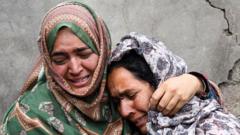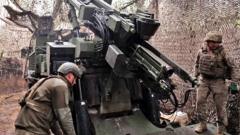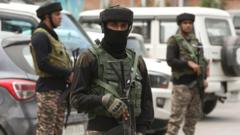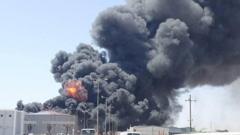The Line of Control serves as both a physical and psychological battleground for those living in its shadow, with families bearing the brunt of geopolitical tensions.
**Tensions at the Line of Control: A Border Ruled by Fear and Conflict**

**Tensions at the Line of Control: A Border Ruled by Fear and Conflict**
Amidst violent escalations, the fragile peace along the India-Pakistan border faces renewed threats.
The Line of Control (LoC) between India and Pakistan embodies a landscape of perpetual instability, where peace teeters precariously on the edge of armed conflict. Following the Pahalgam attack, hostilities flared anew, resulting in significant civilian casualties on both sides. Reports suggest that 16 lives were lost in India, while Pakistan claims the toll to be 40 civilians.
Anam Zakaria, a Pakistani author, highlights how families living near the LoC are caught in the crossfire of fluctuating military ambitions, often forced into bunkers as their livelihoods are annihilated. The LoC, which stretches 740 km, commenced as the Ceasefire Line in 1949 following the first India-Pakistan war, later becoming a symbol of ongoing hostility.
Conflict is endemic along this heavily militarized frontier, with numerous ceasefires failing to provide lasting peace. Historical data reveals a strikingly high number of ceasefire violations, particularly during the early 21st century, leading to widespread displacement and devastation in border areas.
In recent weeks, the renewed tensions have escalated to the point of India halting the Indus Waters Treaty—an agreement crucial for water-sharing—while Pakistan hinted at withdrawing from the 1972 Simla Agreement, a crucial framework acknowledging the LoC.
Experts argue that the escalation of conflict along the LoC may not necessarily stem from top-down political strategies, but rather from localized military dynamics, with field commanders often taking initiatives without central directives.
Despite calls for the recognition of the LoC as an international border, scholars express skepticism regarding its feasibility. The consensus remains that transforming the LoC into a softer boundary demands comprehensive addressing of the broader Kashmir dispute.
In a region defined by daily fears, the uncertainty looms large. As one resident of Pakistan-administered Kashmir put it during the recent shelling: "You never know what will happen next. No one wants to sleep facing the Line of Control tonight," encapsulating the precarious nature of life along one of the world's most dangerous borders.






















